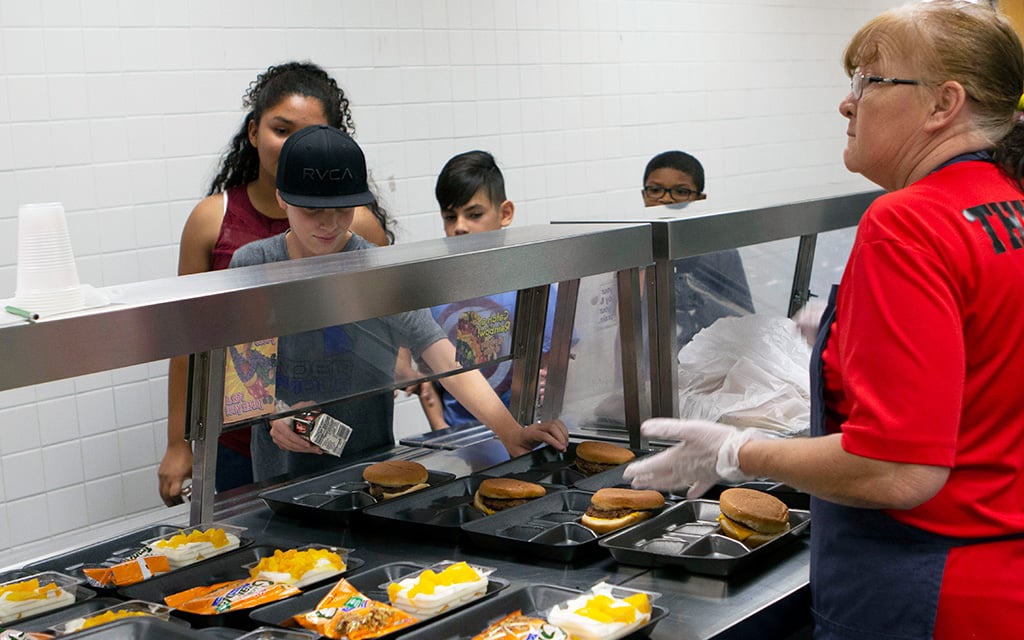PHOENIX – A bill that aims to cut out ultra-processed foods in the state’s public schools is now moving through the Arizona Senate after passing the House with overwhelming support.
HB2164, dubbed the “Arizona Healthy Schools Act,” would prohibit schools that receive federal funding or that participate in assisted meal programs from serving or selling food with certain ingredients. This prohibition would be in effect during normal school hours and includes potassium bromate, colored dyes and more.
If passed, it would be enacted in the 2026-2027 school year. But it could take more time – and money – for it to be successfully implemented in schools.
Jennifer Gordon, child nutrition director at the Laveen Elementary School District, said she testified in support of the bill. Gordon said her school district has already been eliminating such ingredients from their foods and has been going through an “overhaul” of its menus since she started working at Laveen.
Gordon has been there for 10 years.
“It’s definitely something that takes some time to evolve,” Gordon said. “It’s really identifying ingredients that we wanted to eliminate and working with vendors and working on menu planning and recipe development to strategically remove those types of ingredients.”
The Laveen district has a partnership with the Life Time Foundation, a nonprofit that collaborates with organizations to improve children’s health and nutrition. Gordon said the district has received about $90,000 over the past five years to make meal changes. She acknowledged not every school district has access to that funding.

An Arizona bill aims to cut ultra-processed ingredients from foods in public schools, but some school officials say a lack of funding and other challenges may hinder schools from carrying out the bill’s mission. (File photo by Vivian Meza/Cronkite News)
The bill, sponsored by Rep. Leo Biasiucci, R-Lake Havasu City, targets additives it says are contributing to undernourishment and childhood obesity. These ingredients can be found in everyday items such as bread, which schools may have to seek alternatives to.
During a Senate Health and Human Services committee hearing on March 19, Biasiucci said he started digging into the effects of these ingredients and wanted to start small with making an impact.
“If there was one spot that we can clean up our food, it would be our school lunches and for our children, who obviously are the most important part of our population,” Biasiucci said during the meeting.
However, some say it may be hard for schools to cut these ingredients.
“We believe that children’s school lunches should be as healthy as possible, but this bill sets public schools up to fail,” said Melinda Iyer, co-founder and policy director for the advocacy group Civic Engagement Beyond Voting. “These additives are everywhere – some don’t even have to be listed by name on ingredients lists. Potassium bromate, for instance, is in major (packages) of bread.”
Iyer said the bill doesn’t provide additional funding to source healthier ingredients and comes at a time of federal funding cuts to various programs that aid schools.
Ricky Hernandez, chief financial officer at Tucson Unified School District (TUSD), said his district has been feeling some of these cuts. The district previously received funding through a program that allowed them to purchase local produce grown and sold in Tucson – but the program has now ended under federal cuts, Hernandez said.
Hernandez said the district received about $100,000 through this program, and it may have to dip into existing resources to compensate for the loss. However, the majority of the district’s $26 million food services budget is funded through the National School Lunch Program.
“TUSD is what’s called a Community Eligibility Provision district, or CEP, which allows us to now provide free breakfast and lunch access to every student in the school district,” Hernandez said. “We get a reimbursement for every one of those meals based on the reimbursement rates that are set up by the National School Lunch program.”
If it becomes more expensive for schools to use healthier ingredients, it may be more difficult to provide choices for students.
“That creativity to create better meals that make it more inviting for a kid to eat is going to go down,” Hernandez said. “We need our kids to eat in order for us to get paid. So if kids aren’t eating because they have fewer options, then that’s another side that affects the revenue and affects the budget.”
Hernandez said the schools only get reimbursed for the meals the kids consume – not all the meals the schools prepare. He said the rate per meal is under $5, so all the costs to make each meal – staffing, ingredients, deliveries – must fit within this amount.
Another challenge schools are facing is what is brought in by students from outside sources, a facet the bill and the school districts may struggle to target.
“What’s coming into our campuses, that really is going to be continuing to be a problem,” Hernandez said. “We’re not going to be able to stop parents from sending their kids with Gatorades that have red food dye in them. … We’re a state that provides that kind of empowerment to our parents to make decisions about their students.”
Iyer said phasing in healthier food options, through public-private partnerships or attaching funding to the legislation, could help schools switch. Slowly transitioning to alternatives could alleviate these hardships compared to a “wholesale ban” on food groups, Iyer said.
Biasiucci emphasized there was an implementation period included in his bill.
“There is an implementation date because I want schools to be able to catch up and figure out where they need to make the changes,” Biasiucci said during the March 19 committee meeting.
Gordon said these changes are attainable for school districts, even if it does take time. She said Laveen has switched to preparing specific foods in house.
“We have a chipotle sauce, and so we learned how to make that sauce recipe through the help of the chef,” Gordon said. “We use that sauce for our roasted cauliflower … and we also use that sauce in some salad dressings. … .We’ve also changed out our ranch to a scratch-made ranch.”
Gordon described the cost of making things in house as “a wash.” Rather than spending funds on food, the labor costs increase instead.
Despite these challenges, Gordon said it’s important to recognize schools provide healthy options for students, and this bill will continue that mission rather than start it.
“I feel like there’s been a little bit of a narrative about school meals related to this bill that this is going to create a major overhaul to school meals, and it’s really not,” Gordon said. “School meals are very healthy – a lot of thought is put into planning menus. There’s a lot that goes into it, from a funding area and from a federal compliance standpoint.”


